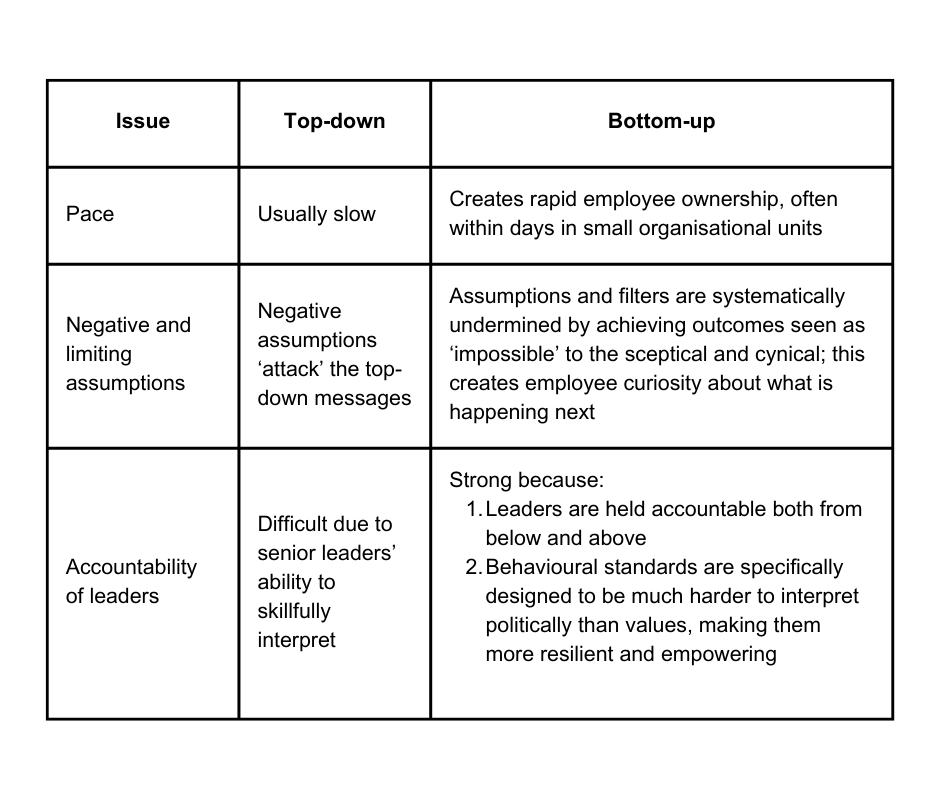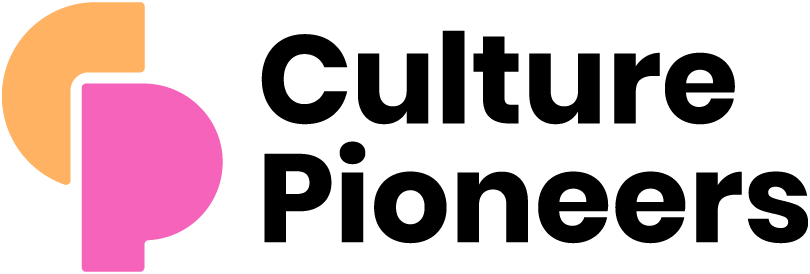
How to build an employee-owned work culture
byStop wasting time trying to sell culture change to employees. Instead, focus on empowering your people to take ownership of a high-performance culture themselves.
When seeking to create a high-performance culture, the conventional approach to making this change is ‘top-down’. It involves senior leadership codifying the new culture and then exhausting themselves in a relentless effort to ‘sell’ it to employees.
There are often elements of employee voice in this process, but the key decisions and the specific words used to articulate the new culture are decided upon by this senior group or its advisors.
Why launch culture change from the top-down, however, when a widespread and deep employee commitment to such a culture can be created much quicker and more sustainably by the employees themselves?
Why create an employee-owned culture?
The advantages of a bottom-up approach are summarised in the table below:

How do employees create their own culture?
To maximise authenticity and employee ownership of the new culture, a number of key prerequisites are needed:
Employees must not merely be ‘consulted’ or ‘involved’ in the codification of the new culture, they must make decisions,
Employees must be empowered to pursue innovative and creative policy changes in a scientific and structured way.
Any existing management policies, such as corporate value systems, should not limit the scope and thus the creativity, of these decisions,
All employees, not merely a cross-section, need to make the decisions. This prevents anyone saying afterwards “I didn’t decide this culture/these behavioural standards”.
To equip this culture to succeed in highly competitive markets, it must deliver high-performance and continuous improvement. The new culture’s role is to both sustain the gains made in the early stages and to equip the organisation to better meet future, and currently unknown, challenges.
Engagement needs employee enablement from current policy owners
As an ex-HR director I recognise that we can accidently hamper radical change. We become newsworthy when we get things wrong and are taken for granted for all our activities that stop things going wrong. This, understandably, can make us risk averse, damaging our reputation among key executives.
Employee enablement is crucial because highly engaged employees crashing headlong into unsympathetic policy roadblocks will quickly dissipate engagement and bolster cynicism.
Employees must be empowered to pursue innovative and creative policy changes in a scientific and structured way that challenges the policies owned by functional leaders. We need humility here.
By engaging openly, we will enhance our reputation as a function. In summary: it doesn’t matter that the conventional approach is x - the conventional approaches are often unfriendly to end-users and sub-optimal for engagement and enablement.
Practice what you preach
In one large factory (3000+ employees) an employee-owned culture was created that addressed head-on the dangers of reporting inaccurate glowing results upwards (i.e. shown as green on the performance dashboard). One of its employee-created behavioural standards states: “we won’t do the wrong thing to appear green”.
Having that as a publicly visible and modelled behavioural standard was far more culturally powerful than any whistle-blower charter, important though such charters are. The public frank discussion necessary to agree it changed the culture much quicker, and because it was scripted by employees not by management, it was owned by employees.
The key to removing barriers of all types is empowering highly skilled facilitators at all levels, who are credible.
In another organisation, first line leaders successfully but respectfully challenged their director in public, based on an employee created behavioural standard stating that any breach of standards should be respectfully challenged.
This successful challenge in turn consolidated the new psychologically safe culture and the role of respectful challenge as an agreed mechanism for maintaining cultural standards while avoiding accusatory ‘calling out’ behaviours.
Implement meaningful diversity by challenging risk-averse barriers to promotion
In every organisation, the latent capabilities of many employees lie dormant, invisible to management. By removing the barriers to promotion that exist in a risk-averse culture, tangible evidence of meaningful change is shown. In turn, this undermines any cynicism quickly.
The key to removing barriers of all types is empowering highly skilled facilitators at all levels, who are credible to their peer-group. This will significantly increase the volume and quality of commercially and emotionally literate conversations.
Imagine the cumulative impact of those conversations on your organisation’s problem-solving, innovation, conflict prevention, and cognitive and social diversity.
Adopting employee created and specifically non-divisive approaches to controversial issues creates genuine psychological safety. This prevents inauthentic tick-box behaviour, while respecting employees’ freedom of belief.
Design leadership development specifically to nurture an employee-owned culture
Organisations tend to rely on existing, conventional leadership development to support their culture change efforts. It is more authentic for employees if they see and feel the direct connection between their inputs and efforts, and their leaders’ skills and approaches to issues.
An ‘all-employee’ approach to coaching is not costly to scale across your organisation.
Don’t limit coaching to managers
All employees benefit from learning how to coach. Deploy a coaching approach that is credible with employees from hard science backgrounds who value data and numeracy.
Ensure coaching is not rationed by cost, that it is never what economists call a ‘scarce good’ but is always a ‘common good’.
An ‘all-employee’ approach to coaching is not costly to scale across your organisation; finance will not be a limiting factor.
Challenge the limiting assumption that culture change takes years
There are credible examples of culture change achieved much more quickly than conventional wisdom dictates. If in doubt, talk to those who have done it.
Of course, not all culture change situations are suitable for such an approach, so consider carefully and choose the specific roadmap that aligns with your organisation’s goals and capabilities.
If you’ve been already investing in the wider learning culture of your organisation then it’s time to enter (for free) the 2023 Culture Pioneer Awards.






Replies (0)
Please login or register to join the discussion.
There are currently no replies, be the first to post a reply.